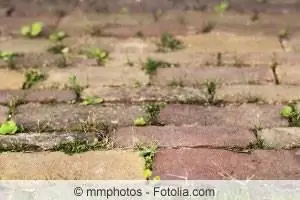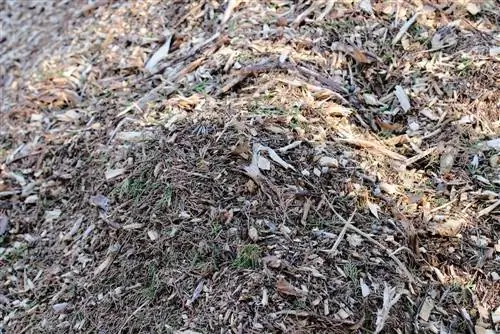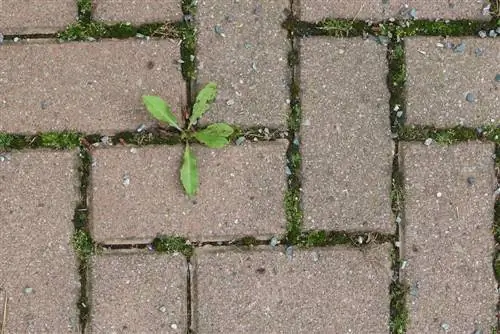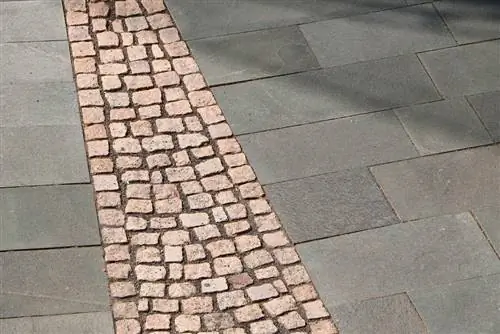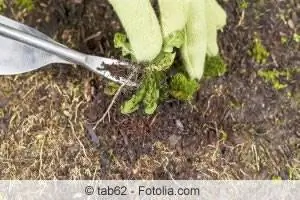- Author admin [email protected].
- Public 2023-12-17 03:39.
- Last modified 2025-01-24 12:45.
Weeds between the paving stones can annoy decent people to the point of rage. However, it can only be successfully eliminated with the exact opposite mental attitude, with stoic calm and steadiness reminiscent of Sisyphus. All other means involve even more work, are harmful or forbidden; Of course, you are only free to reinterpret the weed as an herb, which will ultimately make your work easier.
Good old craftsmanship makes it happen
Of course, you don't have to remove weeds with bare hands (even if the stiletto nails you just made in the nail salon would be ideal for scraping joints). In every hardware store there are beautiful green gardening gloves made of breathable cotton, with non-slip nubs, washable and for around 1 euro. If you get a few meters of “fingernail file protection” from the nail salon, even the stilettos will survive the weed control campaign
Of course, you don't have to go to the joints without tools, you even have a whole range of tools at your disposal:
1. The classic tool for combating weeds between paving stones is the joint scraper. Or the joint scrapers, of which there are quite a few, here is a brief overview from tests of the most common models:
- Combisystem joint scraper with handle, Gardena: Around €15, with a long and short handle, but the thin metal of the joint scraper bends quickly and working becomes laborious
- Electric joint cleaner from Weltbild: Around €80, is supposed to clean quickly, but could not be used straight every time, and the power was also described as expandable
-
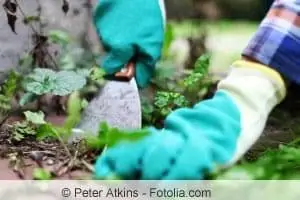
weed weed Joint scraper from FugenKing: Around €25, scrapes with three tips, which improves durability but makes cleaning joints along the curb impossible. When scraping out joints, the tips leave grinding marks on the edges of the slabs, thus destroying the stone slabs, the testers found
- Joint scraper KF-2K from Wolf-Garten: Around 10 €, small, handy with a rubberized handle, work is quick and efficient, but requires bending down, the narrow scraper fits into all joint widths and removes the weeds with the roots
- Fugen up'S joint scraper, S. I. S.-Uphoff: For €16, can be extended with a broom handle, but with or without bending: The 15 stainless steel wires are not intended to remove moss and uncontrolled growth as effortlessly as the manufacturer states, but rather After loosening, the testers tore the weeds out by hand
- Rillenfix joint scraper with telescopic handle from Rillenfix: Around €23, scraper with a diamond-shaped cutting edge made of tungsten-alloyed solid carbide is said to work well, but the telescopic rod and connections are described as rather unstable
- Skil joint scraper from Weedbuster: Around 80, - €, the brush doesn't quite get into narrower joints, the weeds are pushed into them, in wider joints the Weedbuster is said to leave ravines that may require new filling of the joints
and so on, and so on, and the very simple hook-shaped joint scraper made of sturdy metal worked best.
2. If you've just gotten the ultimate workaholic, but the joint scraper is still in the store or has just given up the ghost, the following other devices that you often have in the household will help you:
- The thick screwdriver often has exactly the right joint width
- Even the big meat hook from the kitchen can do amazing things
- The sow tooth is in demand again and the tip also fits into some joints
- Be careful here again, some pig's teeth are shaped in such a way that they scratch the edges of the plate
- Normal garden hoes with a curved shape and sharp edges also help in joints
- Using narrow weed cutters, deep taproots can be pierced into joints
- If you can't pull them well right away, it usually works after they've dried for a few days
- You can do this, for example: B. use a weed tong, but also a large pair of pliers
- With the cutting side of the double hoe, weeding tool and garden disk, you can cut off larger weeds at least close to the ground
- Some weeds cannot stand this in the long term and can then be pulled out easily and with all their roots
Some citizens who “have backs” have purchased practical rolling seats to control weeds in the pavement joints; The do-it-yourselfers among these citizens have built amazing structures with swivel bucket seats. This manual work is probably the only sensible way to remove weeds between paving stones:
Weedex from the poison cabinet: (Unfortunately) forbidden
1. The use of pesticides is prohibited on paved surfaces
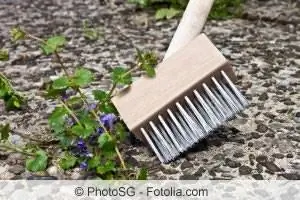
The Plant Protection Act serves to protect the natural environment. The law describes exactly which plant protection products are permitted in home and allotment gardens (private gardens). And it also stipulates that these plant protection products may only be used on areas used for gardening in private gardens, e.g. B. on flower and vegetable beds, lawns, fruit and ornamental trees and hedges. The other way around, this means that the use of plant protection products is prohibited outside of agricultural, forestry or horticultural areas.
Plant protection products must therefore not be applied to sidewalks and paths (not even garden paths), garage driveways or driveways, parking lots, courtyard areas, terraces or other paved areas, regardless of whether they are private property or municipal property acts. In addition, they must not be used on areas used for gardening from which the active ingredients could enter surface water or sewage systems. Since our new Plant Protection Act responded to increasing criticism of the excessive application of critical substances at the beginning of 2012, the options for applying plant protection products have been largely restricted, especially for home and allotment gardeners who are not professionally dependent on the use of these products. The prohibited application of plant protection products is an administrative offense that can be punished with a significant fine, and violations of the prohibitory regulations are increasingly no longer seen as a “petty offense”.
2. The “environmentally friendly” plant protection products
All of this also applies to the famous “chemical-free” crop protection products that are advertised as environmentally friendly or harmless or biodegradable. They also need approval under the Plant Protection Act, with a precisely described application scenario, and environmentally friendly, harmless and biodegradable are fairly relative terms. Be that as it may, what is stated in the Plant Protection Act is a plant protection product that may not be used on paved areas. If a problem weed like ragweed has established itself in your paving joints, you could seek an exemption, which the state Chamber of Agriculture could grant upon written request, but it will probably be more likely to result in help with removal.
Overall, even the environmentally friendly and harmless plant protection products are not always biodegradable very quickly and are certainly not harmless, but are usually labeled with a large number of hazardous substance labels for good reason. You won't necessarily find out what these are and what's actually in the product from the easy-to-read part of the packaging print, but rather from the product's safety data sheet, which the retailer has to give you, but which you can also find out by searching for "product name" + Find “safety data sheet” on the Internet. If you then read that the product advertised as environmentally friendly is “harmful to aquatic organisms,” “must not be in the hands of children,” should only be used with protective gloves and goggles, and so on, you are probably quickly convinced that the Plant Protection Act is right if it wants to prevent the active ingredients from getting into the environment in large quantities and from paving surfaces into the groundwater. Which can also save time, because plant protection products can only be applied in a concentration that can be precisely calculated, and if you mix 13 ml of agent per m² in 87 ml of water per m² for 33.5 m² of paving area in front of your front door, the math alone could do the math takes longer than “weeding” the first 15 meters by hand.
3. Insider tips and home remedies
Insider tips and home remedies that are advertised against weeds between paving stones are very many, and they are often “very dangerous”:
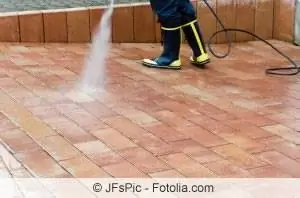
S alt and vinegar are recommended to initially kill weeds in paving joints before removing them. Apart from the fact that it would be interesting to find out why on earth one should do this, this advice could be expensive: s alt and vinegar become pesticides if they are used like pesticides, in this case strictly forbidden pesticides, and interesting fines are imposed on their use stand
Hot water is considered a secret weapon against weeds between paving stones. However, it is doubtful whether this secret weapon is as inexpensive as advertised: Bringing a liter of water to the boil in a kettle takes 3:43 minutes and costs 3.5 cents (www.blitzrechner.de/wasser-kochen). Plus the distance to and from the house, plus 10 seconds of watering, let's say around 5 minutes per liter of water - per plant, because you won't kill more than one plant with one liter of water, and it's probably more pleasant for the last root tip warm shower. For 100 plants, that's 8.33 hours in which you travel from the house to the paved area with the kettle, plus energy costs of 3.50 euros. Not the world, but: If you pull out 100 plants by hand, at a rate of one plant per minute (loosen the roots, dig a little with the joint scraper) you will need 1.66 hours, at no cost.
The situation is similar with weed burners; energy costs are around €5.50 per paving area of 10 x 10 m (www.bioaktuell.ch/de/pflanzenbau/ackerbau/unkrautregulation/direkte-massnahme/abflammen.html, converted hectare costs), plus purchase or rental of the device (gas €30 to €50, with infrared it is at least three figures), the devices are not necessarily environmentally friendly and harmless: the CO2 emissions are relatively high, gas burners are highly flammable, must be used under the strictest possible safety precautions and stored in an optimally ventilated manner; a large proportion of soil-dwelling beneficial insects are destroyed every time. When used in precise doses, infrared burners definitely work well on large areas, but “uncontrolled slash-and-burn” in private gardens tends to have the opposite effect: increased new growth from plants that have been burnt down. The performance of the steam jet/high-pressure cleaner isn't really good either: weeds are flushed out of the joints with a powerful jet, with the joints filled, dirt sprays far around, then the flushed out joints have to be refilled
A convincing alternative
Obviously scratching grout lines isn't one of people's favorite pastimes, or it's due to the growing realization that preserving the natural foundations makes life he althier and more comfortable - the trend is clearly towards grout overgrowth rather than grout scratching.
If you don't feel like having to constantly clean the joints, you could rely on plants that can stay in the joints:
- Ajuga reptans, creeping Günsel, varieties 'Chocolate Chip' and 'Valfredda'
- Isotoma fluviatilis, Blue Bubikopf or Gaudich
- Lysimachia nummularia 'Aurea', yellow-leaved pennywort, variety 'Jenny'
- Mazus reptans, lipmouth, variety 'Purple'
- Sagina subulata, star moss, varieties 'Irish Moss' and 'Scotch Moss'
- Sedum spurium, Caucasus stonecrop, variety 'John Creech'
- Thymus praecox, early flowering thyme
- Thymus praecox 'Coccineus', red creeping thyme
- Thymus pseudolanuginosus, woolly thyme
- Thymus serpyllum, sand thyme, miniature variety 'Elfin'
- Trifolium repens var. atropurpureum, white clover, variety 'Bronze Dutch Clover'
All of these plants are known to be sturdy, show slight differences in height and can therefore be selected to match the joint. For very narrow joints, the small, strong thyme species are recommended, as they offer a little slip protection in winter. Manufactum offers a special mixture for paving joints, seeds of six drought-resistant and hard-wearing herbs, www.manufactum.de/samenmisch-pflasterfugen-p1470090. Seed manufacturer Rieger-Hofmann also offers a special mixture of drought-resistant and hard-wearing herbs for greening and visually enhancing paving joints, the care of which is “in principle through use”, www.rieger-hofmann.de/sortiment/mischen/begruenungen-fuer- the-city-and-settlement-area/17-fugenmisch.html.
Conclusion
People are said to have been seen doing funny dances of anger between paving stones while fighting weeds because they scratched stones or emptied joints. You shouldn't let it get to that point, other insider tips against the growth often turn out to be forbidden or ultimately extremely time-consuming; good old manual work is usually what's left. The currently popular alternative therefore takes a completely different approach and simply redefines the weed.

